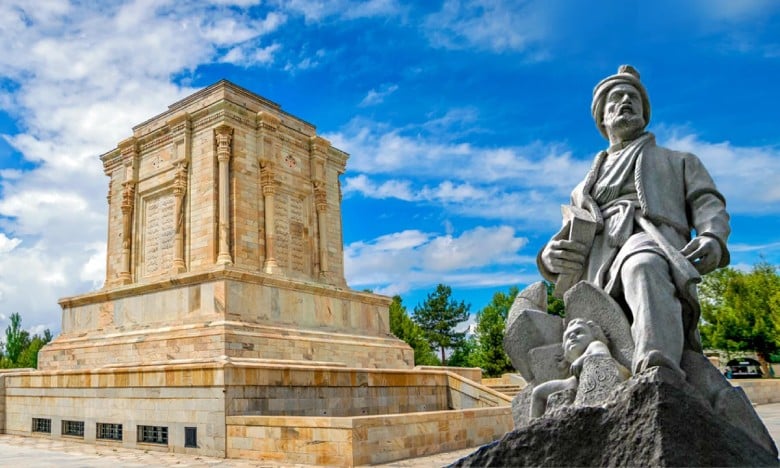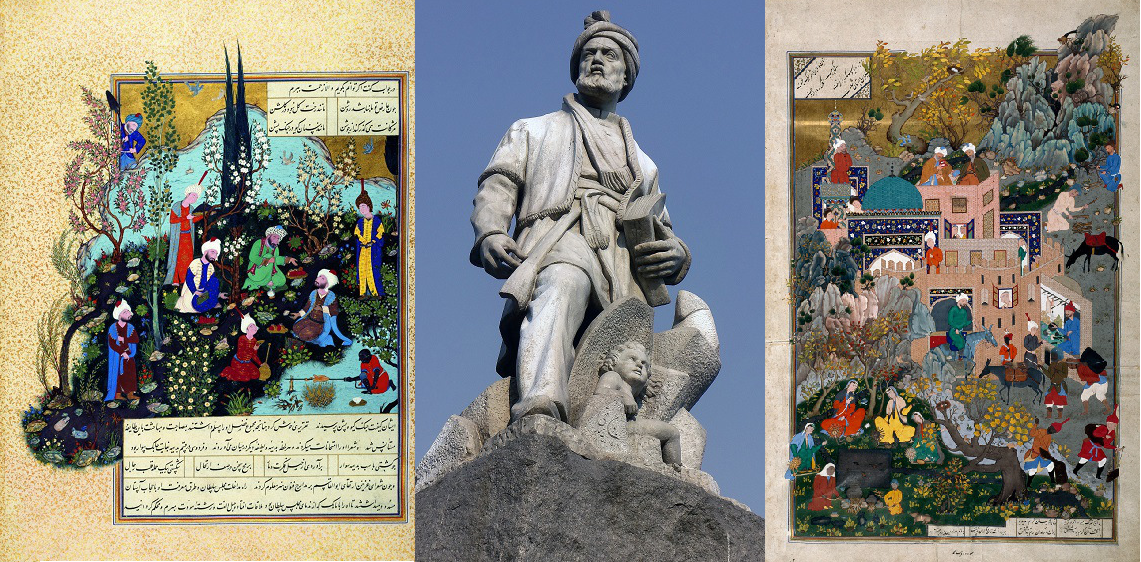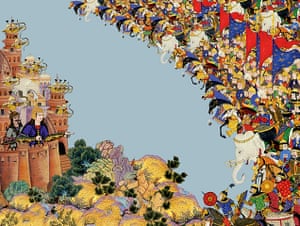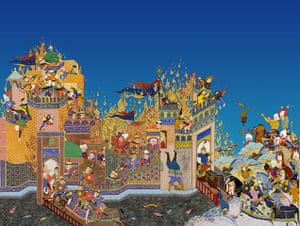First published on 12 July 2013
Ferdowsi the saviour of persia, culture, language, heritage, and civilisation
'When asked recently why the vast majority of Egyptians, the heirs to a great pre-Islamic civilization, speak Arabic rather than Coptic, a leading Egyptian historian replied: ‘Because we had no Ferdowsi.’
‘Ferdowsi wrote the Shahnameh primarily to preserve Persian history, language, and cultural identity, especially in the face of increasing Arab influence following the Arab conquest of Persia. He aimed to revive and celebrate Iran's pre-Islamic heritage, ensuring it wouldn't be forgotten.’
The Lessons of Ferdowsi for Modern Iran
‘Ferdowsi's Shahnameh offers several crucial lessons for modern Iran, primarily centered on the preservation of Persian language and cultural identity, the importance of just and righteous leadership, and the cyclical nature of history and human behavior. The epic poem emphasises the need to learn from the past to build a better future, and it serves as a powerful reminder of Iran's rich heritage and its enduring spirit.’

Ferdowsi: The Voice of Persian Identity and His Enduring Legacy. Photo via SURFIRAN
Ferdowsi: A Poet and the Legend that Saved a Nation
‘Ferdowsi is widely regarded as the preserver of the Persian language and of pre-Islamic Iranian cultural identity. Of all the peoples conquered by the Arabs in the seventh century, the Persians are the only ones who can boast a major literature in the indigenous language that they were using before the conquest. When asked recently why the vast majority of Egyptians, the heirs to a great pre-Islamic civilization, speak Arabic rather than Coptic, a leading Egyptian historian replied: ‘Because we had no Ferdowsi.’- Ferdowsi: the Poet and the Legend
Shahnameh: Poems that Honoured and Rebuild a Nation
‘The Shahnameh is the longest poem ever written by a single author, but length can hardly account for its enduring fame. Ferdowsi’s role in the formation of the Persian language and literary culture is similar to that of Goethe for the Germans, of Pushkin for the Russians, or of Shakespeare for the English-speaking world…
'Since the Arab conquest of Iran in the seventh century, the Persian-speaking world was dominated by Arabic, which was of a different linguistic origin – Semitic as opposed to Indo-European. As an educated aristocrat and a Muslim, Ferdowsi would have known enough Arabic to read and understand the Qur’an. But his choice of vocabulary for the Shahnameh kept the number of Arabic words to an absolute minimum. The metre he chose, motaqareb, is close to the Persian syllabic system. Each verse is independent and the sense does not normally run on into the next verse. Ferdowsi’s style is deliberately archaic, devoid of the ornate language and technical sophistication of his famous contemporaries at Sultan Mahmud’s fashionable court. The vocabulary, the metre, the semantics of the verses, and the relative simplicity of Ferdowsi’s diction suited the epic genre and facilitated the memorization of lengthy passages. Ferdowsi’s claim to fame rests largely on his deliberate invigoration of Persian as a literary medium, thus preserving not only the history of the Iranian people, but also the language in which it was recorded…’-The Shahnameh: a Literary Masterpiece

Ferdowsi’s Shahnameh -The Epic of the Kings with 2 Magnificent Illustrations
from the Aga Khan Museum (Image credit: Simerg.com)
Ferdowsi’s epic poem Shahnameh (“The Book of Kings”) is part myth, part history—it begins with the legend of the birth of the Persian nation and its tumultuous history. It contains magical birds, and superhuman heroes, and centuries-long battles. Written over 1,000 years ago, it was meant to protect Persian collective memory amdist a turbulent sea cultural storms. Originally written in couplets, the new translation and adaptation by Ahmad Sadri retells the mythological tales in prose format. The spectacular illustrations in this edition were created from elements culled from thousands of illuminated manuscripts, lithographs, and miniatures dating from the thirteenth through nineteenth centuries, each panel becomes a new work of art, an exquisite collage of traditional forms.
“After the enormous success of the Lord of the Rings and Game of Thrones, as well as blockbusters such as 300 and Clash of the Titans, the time might be right for Persian mythology to find an audience in the west.
Iran's national epic, the Shahnameh, involves many of the same themes and motifs as popular works of fantasy: heroic quests, magical beasts, devilish monsters, passionate romances, fierce intrigues over power, and monumental conflicts fought across immense spans of time.
Written more than 1,000 years ago by Abolqasem Ferdowsi (940–ca. 1019), the Shahnameh recounts a long, legendary history of the Iranian people from the beginning of civilisation until the historical Arab conquest of the region in the seventh century. The heart of the narrative concerns the adventures of Iran's most celebrated mythological hero, Rostam.
Over the centuries, tales from the Shahnameh have been depicted in a variety of styles around the Middle East and central and sub-continental Asia. Versions illustrated by Persian, Mughal, and Ottoman artists can be found in museums from Istanbul to Los Angeles. For all of its many adaptations, however, it has remained largely unknown in the west except in scholarly circles and among Iranians.
But New York–based artist Hamid Rahmanian's recent illustrated rendition with translator Ahmad Sadri of, Shahnameh: The Epic of the Persian Kings could change that. His images draw on thousands of carefully orchestrated elements from paintings, lithographs, and manuscript miniatures from Iran, Mughal India, and the Ottoman Empire between the 15th and 19th centuries, and convey scenes such as dreams and nightmares rarely if ever depicted in previous versions.
Rahmanian describes his process as akin to that of a movie editor splicing frames for a montage or a DJ blending tracks for a mash-up. Taking the visual elements out of their original context to produce new pictures also adds a new layer to their meaning. The images not only convey the Shahnameh's stories, they also bring traditions of literary illustration from distant places and times into intimate dialogue. The unique result is a fresh visual narration that makes the ancient text feel as if it is flows seamlessly, like a finely edited film.”
About the Author
A little over a thousand years ago the Persian poet Ferdowsi of Tous collected and put into heroic verse the millennium-old mythological and epic traditions of Iran. It took him thirty years to write the sixty thousand verses that comprise the Shahnameh or “The Book of Kings”. This monumental work begins with legends of the birth of the Persian nationhood and ends with the Arab invasion of Persia. Written in the aftermath of that national trauma, Shahnameh was meant to harbour the Persian collective memory, language, and culture in a turbulent sea of many historical storms.
'How does one begin an article about the greatest poet in Iranian history?'
Ferdowsi's Shahkar (PBS, Tehran Bureau, 2010)
Ahmad Sadri is currently professor of Sociology and Anthropology and James P. Gorter Chair of Islamic World Studies at Lake Forest College. He has written two books in Persian: “Reviving the Concept of Civilizations,” and “An Apocalypse soon.”
Hamid Rahmanian is a filmmaker and graphic artist whose work has been exhibited in international competitions and publications. His narrative and documentary films have premiered at festivals such as Sundance, Toronto, Tribeca, and Venice, and have gained international recognition for their socially conscious storylines.
See the original article HERE
Epic Iranian tale gets an intimate upgrade - in pictures

Sohrab assesses his enemy's strength and looks for his father, Rostam Illustration: Hamid Rahmanian

Iranian troops attack the enemy castle of Alanan to revenge Iraj's death Illustration: Hamid Rahmanian
See more illustrations HERE
A Must-read Article
Ethics of War and Peace in the Shahnameh of Ferdowsi
'This article provides an overview of the ethics of war and peace in the most important and normatively influential work of epic literature known in the eastern lands of Islam, namely the Shahnameh of Ferdowsi (d. 1020 CE). As one of the greatest sources of the Iranian cultural identity for over a millennium, Shahnameh (lit. The book of kings) defines normative ideals in the ethics of war and peace within narratives that connect the ancient history of Iran to its mythical eras and in effect to both the medieval time of the epic's authorship and modern Iranian identity. By identifying limits, standards and legitimacy for war and peace in Shahnameh, this article aims to facilitate an Iranian contribution to the global literature and practice on peacemaking that has deep roots in the Islamo-Persian tradition.' -Read more
